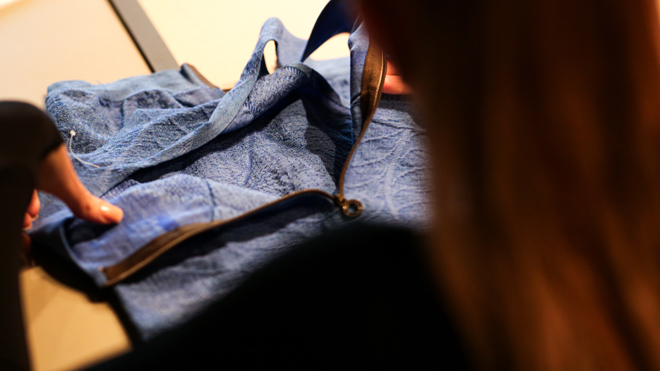New aircraft seating concept using wool

In a forward-thinking collaboration, The Woolmark Company and Sydney-based Caon Design Office have created a revolutionary aircraft seat design that reimagines the future of premium cabin travel and features a 3D knitted wool blend membrane.
The innovative design concept, Modulo, challenges the status quo of aircraft cabin interiors by addressing key issues such as weight reduction, sustainability, and the need for frequent cabin refreshes. It utilises a 3D knitted wool blend membrane that also provides a unique tactile and visual passenger experience.
AWI CEO John Roberts says the collaboration between AWI subsidiary The Woolmark Company and Caon Design Office demonstrates a shared commitment to drive innovative solutions with eco-conscious design principles.
“By harnessing the benefits of Merino wool, such as breathability, moisture-wicking properties, and luxurious softness, Modulo demonstrates how Merino wool is uniquely positioned to elevate the future of travel through unparalleled comfort and enhanced sustainability,” John said.
“This initiative is an example of how AWI and The Woolmark Company explore and develop new applications for wool, for the benefit of Australian woolgrowers.”
Caon Design Office is a multi-disciplinary design practice based in Sydney. The studio has worked for a wide range of companies including Qantas.
What is Modulo?
The Modulo Aircraft Seat Concept, developed in collaboration between Caon Design Office and The Woolmark Company.
Modulo comprises a distinctive fabric membrane fastened to a lightweight yet robust framework of titanium, aluminium, and carbon fibre. The semi-transparent skin, shaped by advanced 3D knitting techniques, forms a wool blend that is structural yet pliable. Carbon and elastic polymers integrated into the fabric grant dynamic flexibility, enabling the seat to transition smoothly from an open space to a private enclosure.
“This initiative is an example of how AWI and The Woolmark Company explore and develop new applications for wool, for the benefit of Australian woolgrowers.”
- John Roberts, AWI CEO
Aided by a sophisticated quick-release mechanism, the wool membrane skin can be interchanged as effortlessly as a standard seat cover. This allows airlines to not only adapt their cabin aesthetics with minimal effort and downtime, it also enables airlines to easily adapt the cabin’s ambiance to reflect seasonal themes, ensuring that the cabin environment remains contemporary and engaging throughout the year.
“In exploring how to expand the capability of the wool fibre within the airline industry we address a major bugbear of airlines in that they have to spend huge sums of money and time in changing the feel of their cabin interiors,” said the head Caon Design Office, industrial designer David Caon.
“Passengers benefit too by having more of this wonderful material which breathes and allows us to play with light and opacity to create new scenarios for privacy and relaxation.”
The knitting technology employed in Modulo also allows for the strategic integration of wadding within specific sections of the fabric. This design choice significantly diminishes the reliance on traditional foam, leading to a seating solution that is both lighter in weight and more considerate of environmental impacts.
In addition, Modulo's design is smartly integrated with sensors and technology to elevate the comfort and safety of passengers. These sensors actively monitor and regulate seat temperature for optimal comfort. They also prompt passengers to move periodically, mitigating health risks associated with prolonged immobility such as deep vein thrombosis (DVT).
Other potential applications
As the transport industry moves towards more sustainable and technologically advanced options, Modulo’s adaptability ensures that it can be seamlessly integrated across various other travel ecosystems beyond aviation.
The visionary design could also extend to future modes of transportation, with its lightweight structure and modular nature ideal for the evolving landscapes of hyperloops, autonomous vehicles and electric aircraft.
Modulo is not merely a design study; it represents a leap forward in interior design, focusing on passenger experience, environmental impact, and operational efficiency.
More information: www.woolmark.com/modulo
This article appeared in the June 2024 edition of AWI’s Beyond the Bale magazine. Reproduction of the article is encouraged.














